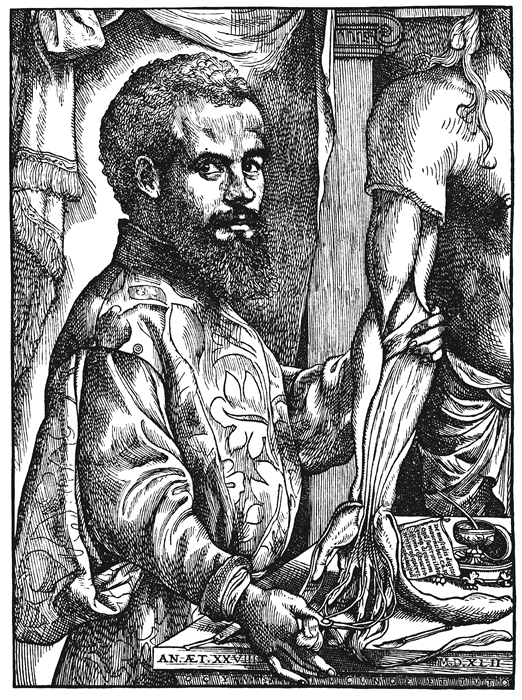Andreas Vesalius:
De Humani Corporis Fabrica
Translation and Commentary:
On the Fabric of the Human Body
Book I may now be read on the project website, which also contains relevant essays and images. Book II will soon be added, followed by the entire Latin text of the 1543 Fabrica.
Andreas Vesalius' De humani corporis fabrica (1543, 1555): an annotated English translation with original illustrations digitized and restored. A project co-authored with Malcolm H. Hast, Professor of Otolaryngology -- Head and Neck Surgery at the Northwestern University Medical School, first funded by concurrent three-year grants (1995-1998) from the National Endowment for the Humanities and the National Institutes of Health (National Library of Medicine) and currently by additional grants (see below).
The purpose of this project is to produce a fully annotated English translation of both editions of the anatomy book that revolutionized the study of the human body and its functions. First appearing a little more than 450 years ago, in the same year as Copernicus' De revolutionibus orbium caelestium, Vesalius' Fabrica revealed a microcosm complementary to Copernicus' rearranged macrocosm. In so doing, it brought to an end the scholastic dogma that the authority of Galen was unimpeachable. Galen, the 2nd century AD medical writer whose culture forbade the dissection of human cadavers, based his anatomy primarily on the barbary ape and common quadrupeds such as cattle, pigs, and dogs. Vesalius grew up in a scientific world caught between the authority of the ancients and the growing practise of human dissection. By demonstrating errors of Galen in public anatomies, and insisting that medical students test the facts of human anatomy with their own hands and eyes, Vesalius put the study of science and medicine on a new course that led to the discovery of the circulation of blood by William Harvey in 1628.

The Fabrica was the work of a young man still in his twenties who had acquired a Humanist style of neoclassical Latinity as a teenager at the University of Louvain. His love of anatomical complexity is reflected in a densely complicated Latin style described by Singer and Rabin as a "torturous, superelaborate, repetitious rhodomontade'' that defies ready understanding, even by professional Latinists. Much of the influence of the Fabrica was transmitted by the remarkable woodcuts made to illustrate Vesalius' work. But Vesalius worked obsessively on his Latin text even after its publication, making thousands of purely stylistic as well as substantive changes in the text of the 1555 edition of the Fabrica. Thus he was in his own eyes a man of letters, and it was through his writing that he sought to make his mark.
Yet until the end of the last century, only scraps of his masterwork had been translated into English, the largest fragment being most of Book Seven on the brain, translated by William Singer in 1952. C.D. O'Malley translated the preface and numerous short passages of biographical interest in his 1964 biography of Vesalius. More recently, W. F. Richardson has translated Books One and Two of the first edition (1543). But the bulk of this enormous book, which totals about 350,000 words, remains locked in the author's formidable Latin, otherwise available only in a 1950 Russian translation, produced over a period of two decades by V.N. Ternovsky and S.P. Shestakov.
This project will make available to historians and other scholars in the arts and sciences an annotated English text of the entire Fabrica, both the 1543 and the 1555 editions, with digitally scanned and reconstructed woodcut illustrations, modern anatomical terms for the parts discussed, verified citations of ancient authors mentioned, and identifications of persons named in the text. With a new index, it will make the testimony of the Renaissance's greatest anatomist, and one of its three or four leading scientists, fully accessible in English for the first time.
This work is currently supported by grants from the National Endowment for the Humanities (RZ-20239-98) and the National Institutes of Health (National Library of Medicine 2 RO1 LM05675-05).
Three sections of this translation and commentary have been published in article form:- "Andreas Vesalius on the Larynx and Hyoid Bone" (with M.H. Hast). Medical History 37.1: 3-36 (January 1993).
- "Andreas Vesalius on the Teeth: An Annotated Translation from De humani corporis fabrica." (with M.H. Hast). Clinical Anatomy 8: 134-138 (1995).
- "Vesalius on the Variability of the Human Skull: Book I Chapter V of De humani corporis fabrica" (with M.H. Hast). Clinical Anatomy 13: 311-320 (2000).
